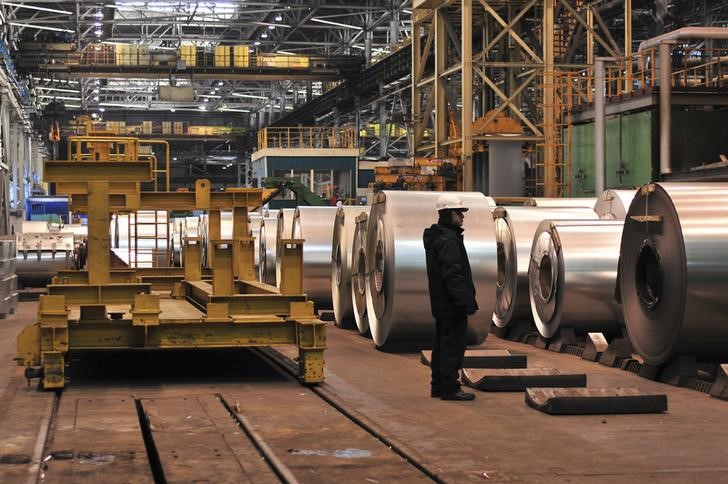(Repeats earlier story with no change in text. The opinions expressed here are those of the author, a columnist for Reuters)
By Clyde Russell
LAUNCESTON, Australia, July 18 (Reuters) - Iron ore's wild price gyrations this year may be masking a small, but significant, shift in the underlying fundamentals for the steel-making ingredient.
While seaborne iron ore remains a well-supplied market, it appears the level of over-supply has been diminishing faster than many expected, leading to an improvement in the supply-demand balance.
This provides some fundamental justification for the rally in spot prices, with the China benchmark index .IO62-CNI=SI up almost 35 percent so far this year.
Let's be clear, there is no reason to believe that iron ore is poised for a major, sustained rally.
But there is reason to be hopeful that prices are more likely to pivot around the $50 a tonne mark, rather than revisit the December 2015 lows of $37 a tonne.
The main reasons for prices finding a floor are improvements on both the supply and demand side.
For demand, this is largely due to China, which buys about two-thirds of seaborne iron ore and is the world's largest steel producer.
China's imports have jumped 9.1 percent to 493.7 million tonnes in the first half of 2016 compared to the same period last year, representing a gain of nearly 41 million tonnes.
The strength appears set to continue in the current month, with Thomson Reuters Commodity Research and Forecasts estimating 91.86 million tonnes will arrive at Chinese ports in July, which would be the highest monthly total this year.
Most of this has been on the back of rising steel output, which in turn has been fuelled by expectations of higher domestic infrastructure and construction spending, as well as the reality of rising steel exports.
China's average daily steel output hit a record high in June of 2.316 million tonnes, with the monthly total of 69.47 million tonnes being 1.7 percent above the same month in 2015.
For the first six months of the year, steel output is down 1.1 percent, but that is more a reflection of a weak first two months rather than the recent strength.
Exports of steel products rose to the second-highest on record in June, with total exports for the first half rising 9 percent year-on-year to 57.1 million tonnes.
It's clear that China's efforts to rationalise overcapacity in its vast steel industry are proving difficult to implement and sustain, especially when prices have rallied, thus providing mills with a financial incentive to keep producing.
This is the biggest risk for the demand side for iron ore, as any reduction in Chinese steel output will rapidly flow through to iron ore demand.
There is another positive for imports of iron ore, with China's domestic mine output sagging 5.9 percent in the first five months of 2016 compared to the same period last year.
While this only represents a cut of about 29 million tonnes of largely low-grade iron ore, it does lend support to rising imports.
SUPPLY GROWTH EASING
The other side of the equation is supply and while iron ore remains a market that leans towards oversupply, the surplus output appears to be gradually easing.
The 41-million tonne increase in China's iron ore imports in the first six months of 2016 probably hasn't been matched by a similar spike in output by the two major exporters, Australia and Brazil.
While Australia's exports have been boosted by the start up of the 56-million tonne a year Roy Hill mine in Western Australia state, shipments by other top producers have been largely static or lower.
Rio Tinto (LON:RIO) RIO.AX expects to ship less iron ore in 2017 than it does this year, with a target of about 340 million tonnes compared with 350 million for this year.
This year's target is achievable, but will require a strong second-half performance from the Anglo-Australian miner.
Australia's second-largest producer, BHP Billiton (LON:BLT) BHP.AX , trimmed its output target for the 2015-16 fiscal year by 10 million tonnes to 260 million tonnes.
Brazil's Vale VALE5.SA , which vies with Rio for the title of the world's biggest iron ore producer, has also indicated it expects 2016 production of around 340-350 million tonnes, roughly in line with 2015 output of 345.9 million.
It may be stretching a long bow to say iron ore producers are now exercising supply discipline, but it does appear they have finally realised that relentless expansion was not in their interests.
If the rate of new tonnes being added to the seaborne iron ore market can continue to slow, if China's domestic mine output maintains its weakening trend and if China's steel sector maintains output at current levels, it's possible that iron ore's outlook can be positive.
These are big "ifs," but at least they are within the realms of possibility, which is a step-change from the relentless gloom of the iron ore sector for the past few years. (Editing by Ed Davies)
